

| This 58,000-square-foot complex was designed by the Pritzker Prize-winning Spanish architect Rafael Moneo. It is the third largest cathedral in the world and the first cathedral to be built in the United States in more than thirty years. Numerous criticisms have been waged from the cost of the cathedral and its accoutrements to the unusual post modern architectural style, which some say is like an imposing fortress. Our Lady of the Angels Cathedral was also criticized for its departure from historical California Mission-style architecture and aesthetics. Still, the Cathedral is built with concrete in the color of the adobe walls of the California Missions. In addition, the separate 150 foot tall campanile (bell tower), in spite of its modern style, might suggest the Mission tradition. (See page 2 for views of the campanile) | ||
 |
Google mapThe Cathedral is located adjacent to a major freeway. According to Moneo, just as many European cathedrals are built near rivers, the Hollywood Freeway was Los Angeles' river of transportation, the connection of people to each other. The site is located between the Civic Center and the Cultural Center of the city. The front of the Cathedral faces roughly east while the west end is closed off against a very busy street. (See page 2) Entry into the Cathedral precinct is from the south where a large plaza is situated below the church. See photos below. |
|
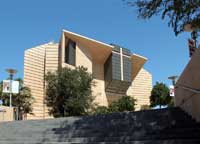 |
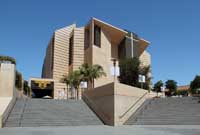
|
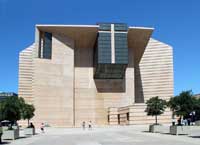
|
| Usually defined as post modern in style, the church seems to avoid right angles while using acute and obtuse angles. The Cathedral's web site adds: "This geometry contributes to the Cathedral's feeling of mystery and its aura of majesty." | 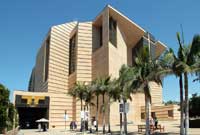
|
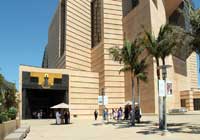
|
| The statue called The Virgin Mary above the entrance was also designed by Graham. Proceeding through the monumental doors visitors enter the 200 feet long south ambulatory that runs the length of the cathedral from east to west. | ||
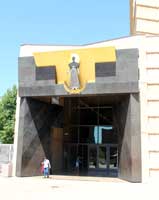
|
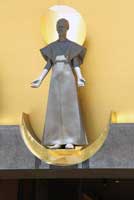
|
Side entrance with bronze doors (not pictured) designed by Los Angeles sculptor Robert Graham |
Post modern angles |
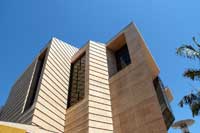
|

|
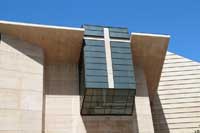
|
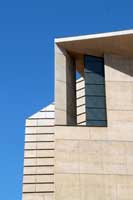
|
"A 50 foot concrete cross "lantern" adorns the front of the Cathedral. At night its glass- protected alabaster windows are illuminated and can be seen at a far distance" (Cathedral web site). |
Lower plaza in front of the front facadeApparently Moneo did not want the entrance to the cathedral to be directly from the street. Thus one enters through a lower plaza, complete with benches and fountains, up the grand staircase, through the upper plaza and on toward the entrance crowned by a statue of the Virgin. The Cathedral's web site says: '"I wanted both a public space," said Moneo, "and something else, what it is that people seek when they go to church." To the architect, the logic of these two competing interests suggested, first of all, a series of "buffering, intermediating spaces" -- plazas, staircases, colonnades, and an unorthodox entry.' | ||

|
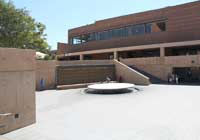
|
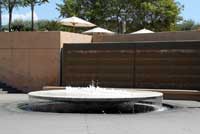
|
 Click here to return to index of art historical sites.
Click here to return to index of art historical sites.
 Click here to return to index of artists and architects.
Click here to return to index of artists and architects.
 Click here to return to chronological index.
Click here to return to chronological index.
 Click here to see the home page of Bluffton College.
Click here to see the home page of Bluffton College.

